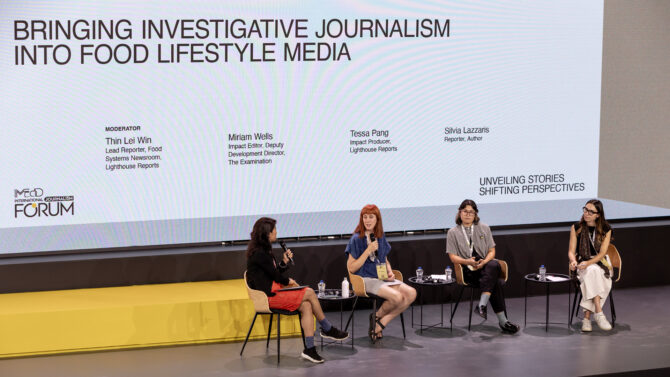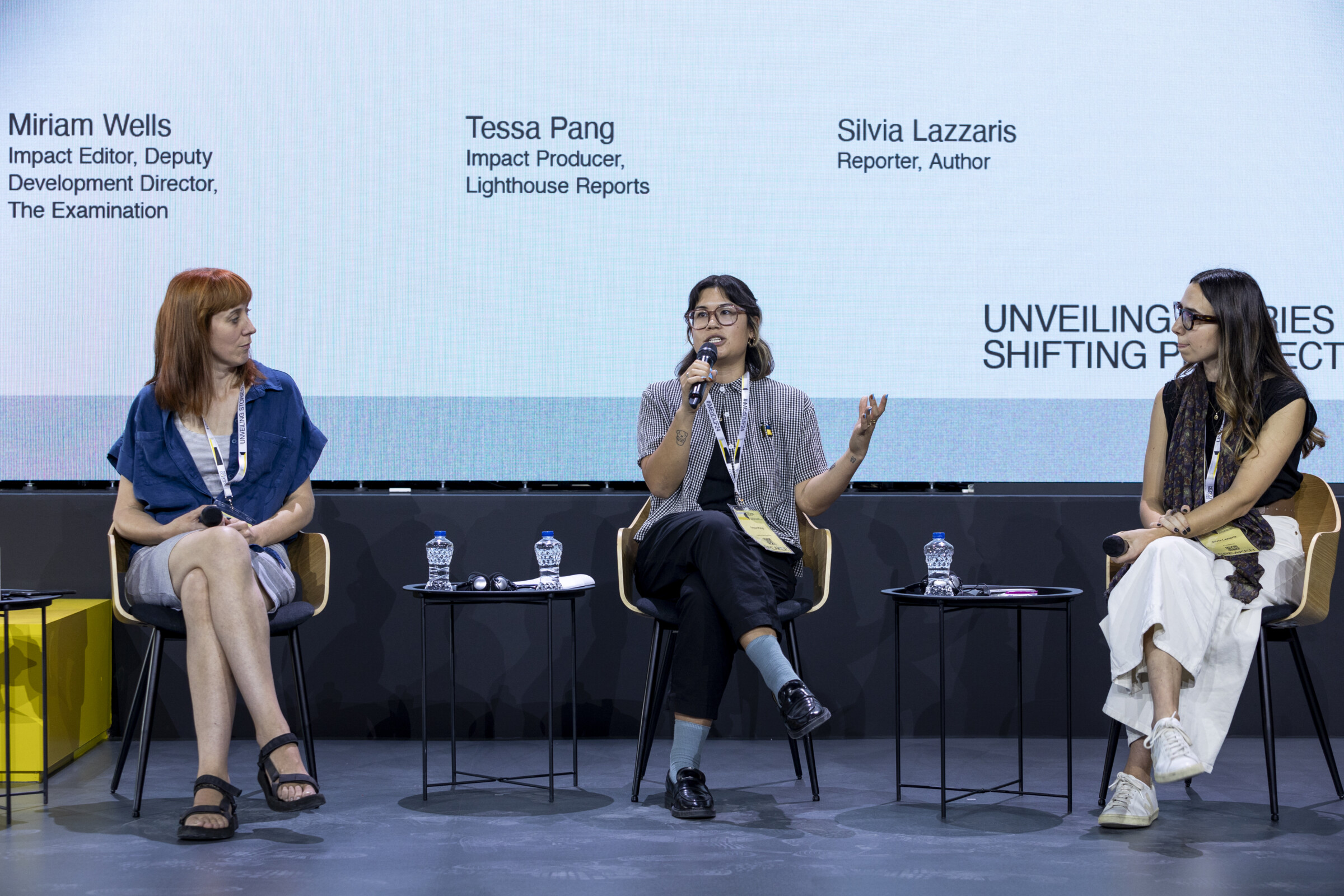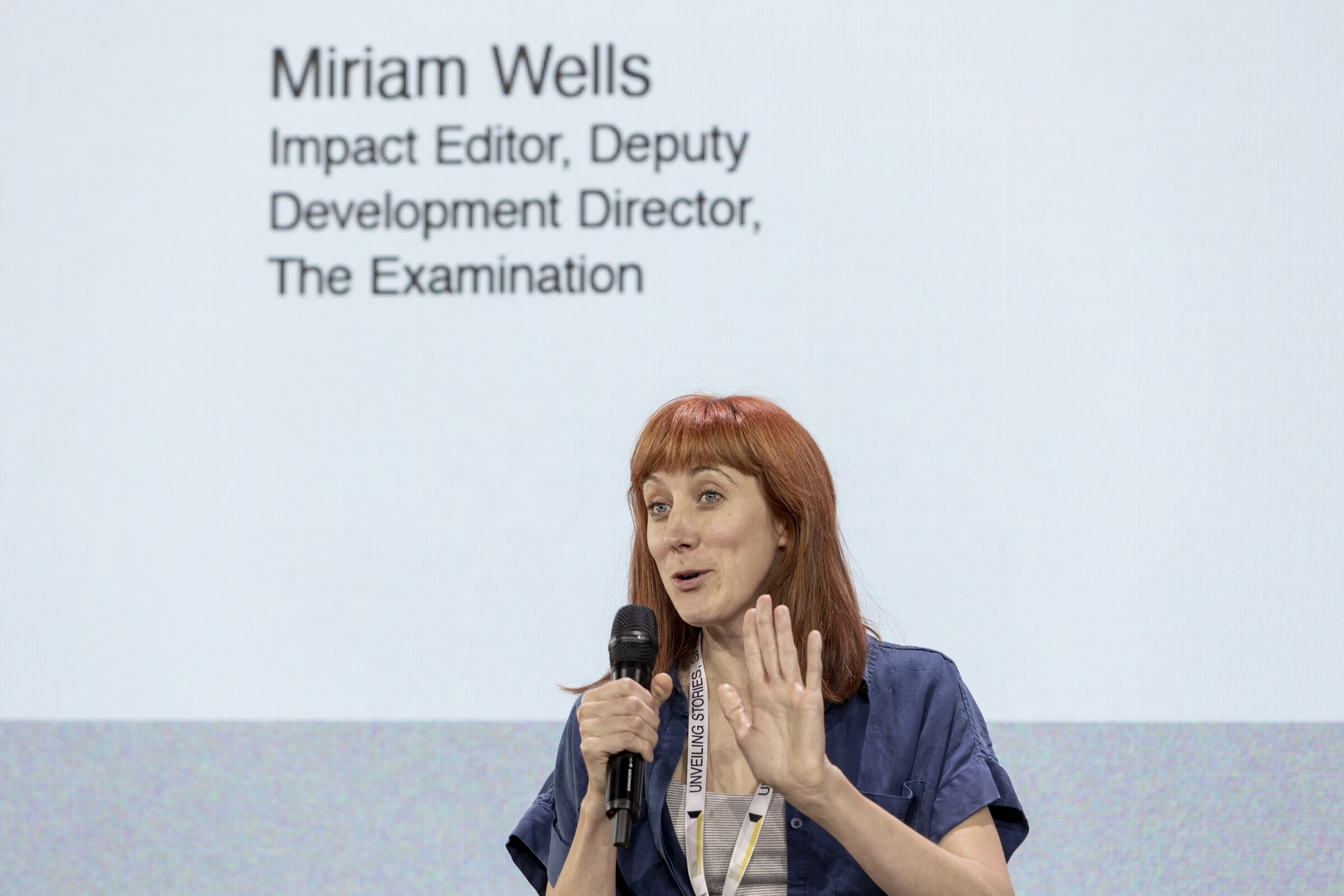How can journalists use creative formats to combat food industry misinformation? Isaac Pollock, a University of Pennsylvania student, and iMEdD’s International Journalism Forum Pop-Up Newsroom reporter, highlights key insights from a panel of female investigative journalists, specializing in food-related investigations.
Food content dominates social media, with over 860 million Instagram users engaging with it daily. But beneath the glossy posts, serious issues persist: 9% of the global population faces hunger, obesity rates are climbing, just four companies control nearly 70% of the food market, and about a third of global greenhouse gas emissions are tied to the way we produce, process, transport, consume, and discard food.
Thin Lei Win, the lead food systems reporter at Lighthouse Reports and moderator of the panel ‘Bringing Investigative Journalism into Food Media Lifestyle,’ used this data to highlight striking disparities and launch the discussion at the iMEdD International Journalism Forum in Athens.
The discussion between Miriam Wells, Impact Editor at The Examination; Tessa Pang, Impact Producer at Lighthouse Reports; and Silvia Lazzaris, a freelance reporter and author, focused on how to educate audiences of food-related entertainment media about the harm that food systems and Big Agriculture have caused to the environment and public health.
Bringing investigative journalism into food lifestyle media

At iMEdD’s International Journalism Forum, Miriam Wells, Tessa Pang, Silvia Lazzaris, and Thin Lei Win discussed how journalists can effectively report on what ends up on our plates and the importance of making stories about the food industry as engaging as content by food influencers. Graduate student Marco Postigo Storel from Columbia University selected excerpts from these discussions for YouTube Shorts as part of the Forum’s Pop-Up Newsroom.
Food Industry Lobbying Shapes Consumer Choices
Win started the discussion by asking the panelists to share their investigations that broke through the ‘policy bubble’ and resonated with the public.
Pang answered first, introducing the audience to Lighthouse Reports’ 2023 investigation into the meat lobby in the EU. “There was really, really aggressive lobbying by the meat industry behind the kind of scrapping of [animal welfare] legislative policies [in the EU],” Pang said. The investigation was an opportunity to demonstrate to people who care about shopping more ethically that some industries and lobbies are working against it, she added. It was also a way to make the audience act against them, said Pang. To reach younger audiences, they worked with Factanza, a social media page based in Italy. They produced a story titled ‘What is lobbying?’ and used food “as a lens to educate people about the structures and powers that make decisions around food policies and what we can eat,” added Pang.

Then, Silvia Lazzaris spoke about an investigation she did into the Dublin Declaration, a document signed by 1,200 scientists that tried to “downplay a lot of the science that has exposed for many years at this point the environmental and health issues related with meat production and consumption,” Lazzaris said. She added that though the report claimed to be independent, “it was published in a peer-reviewed journal, but that journal was fully owned by the [meat] industry.”
Next, Miriam Wells explained a two-part investigation The Examination did in April 2024, part of which focused on the food industry partnering with dieticians to sell products in often undisclosed advertisements on social media. “We looked specifically at [the food industry]… and how it sort of launched this multi-pronged campaign kind of attached to the anti-diet messaging, produced research extolling the benefits of anti-diet thinking, and promoted that to registered dietitians at a conference,” she said.
Collaboration and Accountability in Journalism for Social Change
Win then asked Wells and Pang about the importance of coalition-building in their work and how they reach ordinary people beyond the media industry.
Wells talked about the development of her role, as an Impact Editor, saying that the goal of the role is “trying to maximize the real world changes that journalism can bring about, and really thoughtfully and strategically, intentionally designing journalism…so before you even know what you’re going to report on, how you report that story, how you produce that store, how you tell that store, and what you do with that story once it’s done. And alliances are key to everything,” she said. “Journalism is one really important part of the puzzle of social change.”

Journalism is one really important part of the puzzle of social change.
Miriam Wells, Impact Editor at The Examination
Pang expressed her agreement with Wells, adding: “Building that trust and respect and also hearing what is important to different communities is a really important part of that process and does require a little bit of a shift in thinking away from traditional kinds of journalism, which is viewing people as sources or points of information…we’ve been trying to think a little bit more creatively [about] who could be in this coalition or this community of accountability for food.” She emphasized engaging with chefs, influencers, and food writers to identify barriers in discussing structural food issues and finding solutions.
Win then turned to Lazzaris about how she uses social media to share facts and science. Lazzaris, who has been a science reporter for many years, highlighted that being transparent about her process and methods can better engage people. “You don’t need that emotional storytelling. You can just talk about how you’ve reached a conclusion,” she said.
Balancing Food Journalism and Audience Experience
Win’s final question was to ask the panelists how they approach the intersection of food journalism and food lifestyle content in a way that is kind to the consumer; how do they talk about food systems without ruining the joy of food content?
“Through food, you can see where power lies,” said Lazzaris. “You can explain conflicts and wars, the rise and the end of empires…On top of that, of course, we all eat. So we all relate somehow to food in some ways.” She emphasized giving dignity and respect to the beat.
Pang spoke about the difficulties of bridging education and entertainment. “What’s important is educating people about the system that prevents everyday people from accessing nutritious and good food. (…) And then the goal would be for those people who watch [food content] videos to watch the next one with that information in mind, and maybe even go to the comments section and start a discussion there,” she said, adding that journalists need to think a bit more creatively about how they can merge education and entertainment together.
Finally, Wells agreed, and talked about how personal food is for every individual consumer and how education, while important, cannot trump the effect of “regulation about advertising and about taxes and so on.” She said that journalism needs a “big product design movement”, and to “get much more creative and innovative and strategic.”
Watch again the discussion:
Check out all Pop-Up Newsroom 2024 stories here.